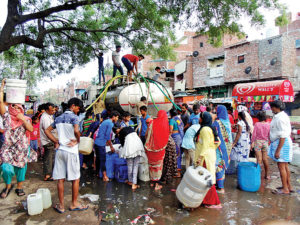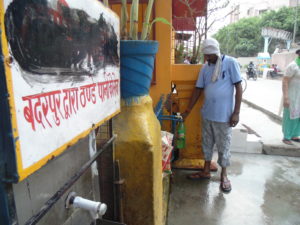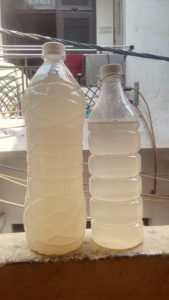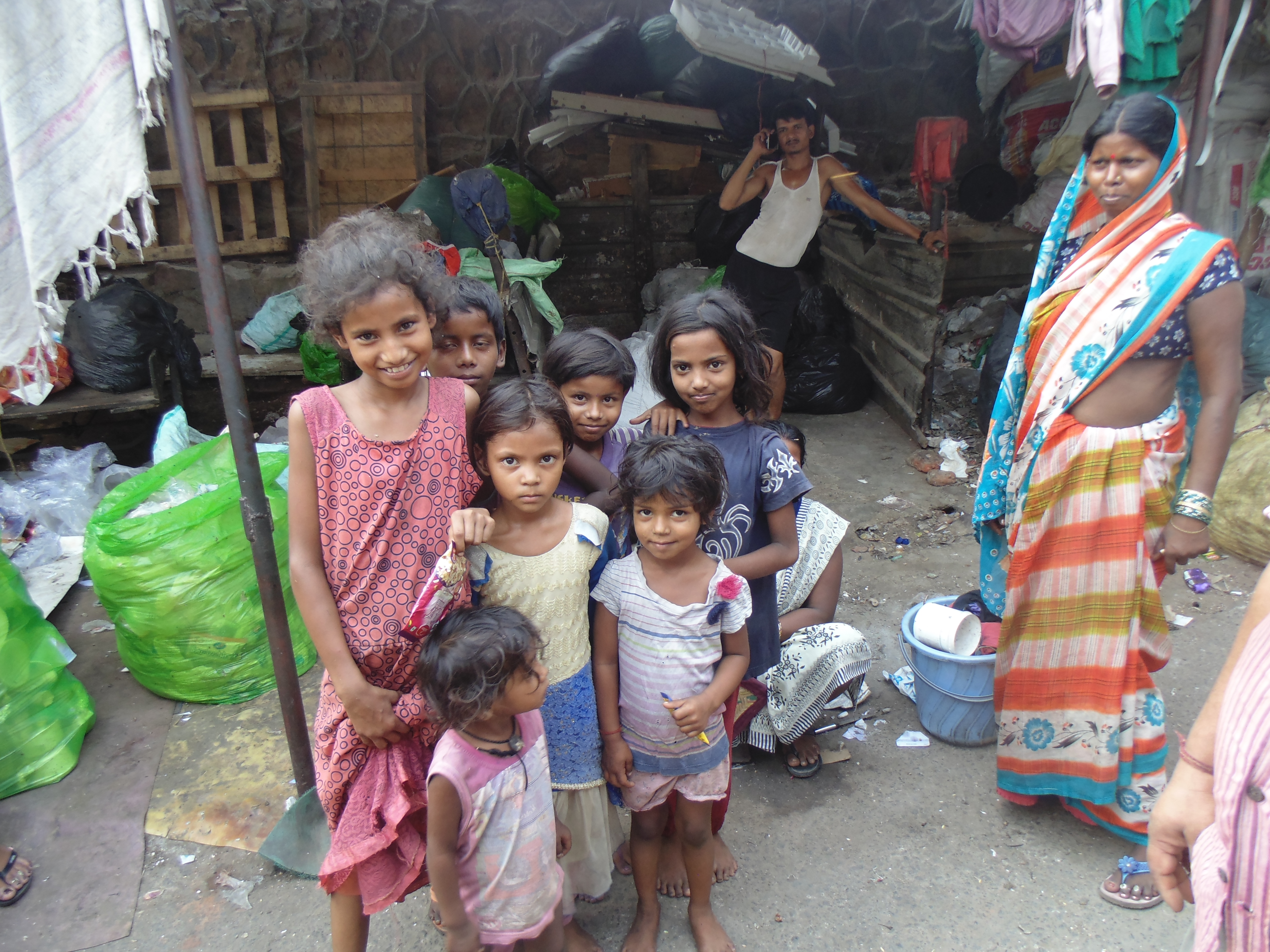Despite promises by Chief Minister Arvind Kejriwal himself, settlements where the poor live are heavily dependent on tankers for their survival
Delhi is one of the cities – including Chennai and Bengaluru – which were warned by a NITI Aayog report of its groundwater running completely dry by 2020. This crisis is already evident in many parts of the city which have to fight for water from Delhi Jal Board tankers or get water unfit for consumption.
In the present scenario, the Chief Minister Arvind Kejriwal went to a few clusters in Delhi promising better water supply, laying of new pipelines and connecting those lying idle.
The city abounds in unauthorised colonies jhuggi clusters and slums, which lack bare essentials that make an area liveable – particularly a sewage system and water pipelines. Like Deoli, which Kejriwal has said will get water in another four months’ time.
There are also places like Harkesh Nagar which Kejriwal also visited during his padyatra, where pipelines were laid out two years ago, according to its residents. They however, are non-functional, with no connection. Only random metal pipes can be seen protruding from the ground with open sewers running parallel to them.
On his part, while Kejriwal goes around making promises, he has also urged the Centre to increase Delhi’s water share, which has remained ‘unchanged’ since 1994.
Harkesh Nagar
This area in Okhla is where Kejriwal promised its residents piped water supply within a week of his visit. That was on June 2. We visited the area on the 25th and there was no sign of this promise being fulfilled in the whole area.
The first resident we spoke with, Rupendra Jha, happens to be a volunteer with Delhi’s ruling party. He claims that the last time he went to complain to a higher authority, he was told the work will be done in 10 days. But the declared deadline has been crossed.
“We are outsiders so they don’t care for us”, he says, taking us to the other side of the JJ cluster, just a few steps away from where he lives. Here, water has been coming through the pipelines. Jha believes it is because the residents on this side are Gujjars, and thus get preferential treatment. He does however add that since they have built their homes on an uneven plain, it is difficult for the water to reach them.
We met Vijender, whose home is in an area receiving water every other day. While not an ideal situation, it is better than Jha’s predicament. Hundreds rush with their buckets and rubber pipes when they hear shouts announcing the Delhi Jal Board water tanker has come.
Archana Bhagat, who runs a grocery store in one of the small lanes, says that tankers come at their own sweet will. “Sometimes at 8 am, then at 2 pm and then sometimes in the evening.”
Many we spoke to however, admit that water tankers come a good few times and have been frequent since the present government came into power.
Sanjay Colony

Some 500 metres away from Harkesh Nagar is Sanjay Colony, a slum area inundated with muck and broken roads. We met Sunita, who said someone had told her that the promise of water meant its taps would begin to flow in “another 10 days”. The water came for 10-15 minutes for about four or five days, according to her, and then stopped.
She runs a small corner shop selling tobacco products, snacks and aerated drinks. While she tells us about the water situation, a young man comes to listen in. Studying in his first year in ITI, Kalyan has been living there since he was born.
Instead of blaming the present government of not living up to its promises he thinks there’s a ploy by its rivals to spoil the chances of Aam Aadmi Party (AAP) to consolidate votes for the Assembly elections next year. “The other party knows that water to the jhuggis mean undivided votes for the AAP,” he says. Furthermore, Kalyan accuses that “when the DJB put in the connection, someone came a few days later and broke the booster. Then when that was fixed, they broke the main pipeline.” This was his explanation for the disruption in water supply.
For now, they have the tankers which come at least “five to six times each day in different lanes”. While we stand talking, Sunita looks through the corner of her eyes, and announces: “The tankers are here”.
We walk out and see people waiting with large rubber pipes in their arms – the ones who have them, get the most out of the tankers.
But the reality is that no matter how many times a tanker comes to their locality, they have to run each time to get the few litres they can manage. As we watched, it took just about five minutes for the tanker to empty out. Children, women and men all hurl themselves at the tanker, trying to grab the pipe to fill into their buckets. Those who lose this battle walk away with empty buckets, waiting for the next call of the tanker approaching.
Gautampuri
This area was one that we visited during the Lok Sabha election campaign. Since then, not much seems to have changed. The lanes are still not paved and the sewers, gaping and overwhelming. In Gautampuri, Kejriwal had promised work on sewer lines within 15 days of his visit and roads developed before the monsoon.
However, unlike the other two areas, many homes here have water supply – the main problem is the water is not fit for drinking.

We visited the area on June 24, more than two weeks since Kejriwal had promised homes would receive water “from Ganga”, ostensibly pointing towards water they could drink. Instead they are still buying the 20-litre bottles which look like Bisleri ones, supplied through some local vendor for Rs 20 a bottle.
To save some money, Rajendra Kumar fills his bottles from a tap right outside a temple. He sits by his shop with five 2-litre bottles, waiting for his son to turn up so that he can go fill them. While his home has the pipeline, for the past four months the water has been “so dirty sometimes that they cannot even wash their mouths with it”.
Then there’s Vikas Kumar, a resident of the area, who tells us that even for the new water connections, after Kejriwal’s visit the DJB officials came for a day. “The forms were filled and given and since then they have not been seen again”.
Several residents of the BIW camp a short walk away from this JJ cluster say that the quality of water has not improved despite their representations to Kejriwal during his visit. Also, lines installed have not yet got a connection and many have to depend on various spots where the pipes have an outlet in the lanes.
Ishtaqar, a resident, says many people fall ill because of the dirty water supplied. As if the quality of water were not bad enough, the government must look at the civic situation of the area. The connection from Gautampuri to the BIW camp takes one through heaps of garbage. This was cleaned, they say, when Kejriwal visited. The next day, it was back to square one.
The garbage strewn though, would be something fixable if the Municipal Corporation of Delhi (MCD) which falls under the Centre’s ambit, sits up and takes note. The sewers, however, come under the Delhi government’s DJB.
But things don’t seem likely to get better any time soon. The residents even complain that construction work for the sewers has stopped after just a few days work. One points to this as a medium which will eventually create a huge problem during the monsoons.
With the system already over its capacity and clogged, one can only imagine the nightmare it would be walking down those lanes when rains do hit the city. Residents here, though, have braved it. But if the whole city were to run dry, the population of almost two crore would need more than a few tankers of water to live on.
OLD KONDLI

For the past one month, Old Kondli’s D-block area which falls under East Delhi has faced a water crisis. Unlike the others featured in this report, the homes here receive water through pipelines but the quality of the supply itself is beyond questionable for the said months.
The water supplied every morning and evening is dark, and smells foul, leaving residents to rely on water tankers from the Delhi Jal Board – which have been visiting the area for the past week.
They also rely on 20 litre bottles of drinking water (for Rs 20) for their daily needs.
A resident Ram Narayan Sinha, says that this problem begun when the main supply line was broken, and sewage entered the pipeline carrying water supply. With the main supply now fixed, slowly the colour of the water has become from a muddy brown to a yellowish cloudy colour.
The residents have had to face this predicament in a stressful time like Delhi’s summer.





